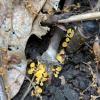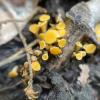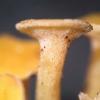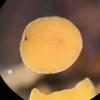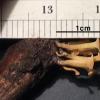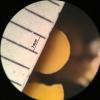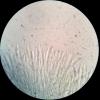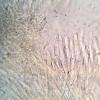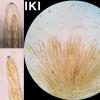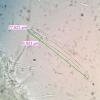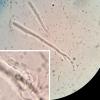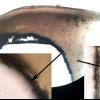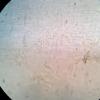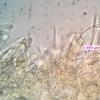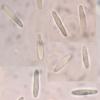
20-12-2025 23:08
Patrice TANCHAUDBonsoir, récolte sur sol sablonneux dans l'arri�

21-12-2025 09:32
Hello.A tiny ascomycete found embedded in wood in

20-12-2025 15:47
Mirek GrycHi.These grew on pine wood that was heavily covere

18-12-2025 21:17
Pol DebaenstThe identification took me to Byssonectria deformi

15-12-2025 07:09
 Danny Newman
Danny Newman
indet. Rutstroemiaceae sp. on unk. fallen leavesMc

19-12-2025 10:10
Patrice TANCHAUDBonjour, récolte réalisée en milieu dunaire, a

18-12-2025 17:23
 Bruno Coué
Bruno Coué
Bonjour,je serais heureux d'avoir votre avis sur c
Lachnum pygmaeum?
Ethan Crenson,
27-05-2024 22:10
Hi everyone,
I found these lovely stipitate ascos on an herbaceous stem that was embedded in mud in a New York City park yesterday. My initial thought was Hymenoscyphus, but the microscopy did not fit. This has lanceolate paraphyses. So after a bit of looking I landed on Lachnum pygmaeum.
Apothecia long stipitate, stipes nearly 1cm long, disc about 3mm wide. Yellow hymenium with white floccose stipe.
Asci IKI+ with croziers (I think)
56.0-77.5 x 4.0-6.0µm
Paraphyses lanceolate 68-118 x 3.3-5.5µm
Hairs roughened, septate, some with capitate ends. The width of the capitate ends 4.4-5.6µm
Spores hyaline, fusiform, eguttulate
7-11 x 1.5-2.3µm
Me 8.5-2.0µm
Q 3.6-6.5
Qe 4.4
N=45
Excipulum textura prismatica/intricata
Does this seem correct?
Thank you in advance.
Ethan
Hans-Otto Baral,
27-05-2024 22:25

Re : Lachnum pygmaeum?
Hi Ethan
these plant remains look characteristic, could it be a climber?
Yes, this sounds much like L. pygmaeum, at least I would compare the paper by White (1942) about this species. I am not fully sure if in Europe occurs the same species. This complex would be interesting to study in more depth. When reviewing a paper about the secondary metabolites of L. papyraceum by Marc Stadler, I made a small ITS tree with what is available around this species, and it turned out that there exist several like papyraceum and several like pygmaeum, together with L. subvirgineum, and which is the typical species is not known.
If you have any opportunity, I much wonder how this find would come out.
Zotto
Ethan Crenson,
28-05-2024 04:47
Re : Lachnum pygmaeum?
It seems to be an asco that doesn't mind living in New York City. I noticed that Fred Seaver collected it in Van Cortlandt Park, Bronx NYC in 1917. I am planning to sequence this collection, so hopefully it will be of some use in ironing out the complex.
Many thanks for your help!
Michel Hairaud,
28-05-2024 07:44

Re : Lachnum pygmaeum?
Hi Ethan and Zotto,
The very short hairs and other characters of your collection remind me of the Lachnum pygmaeum we find in great quantities on post-fire areas , mostly, in Brittany on roots of Ulex .
Zotto, your information about several species of L. pygmaeum incite us to get have our also sequenced .
AmitiésMichel
The very short hairs and other characters of your collection remind me of the Lachnum pygmaeum we find in great quantities on post-fire areas , mostly, in Brittany on roots of Ulex .
Zotto, your information about several species of L. pygmaeum incite us to get have our also sequenced .
AmitiésMichel
Hans-Otto Baral,
28-05-2024 09:10

Re : Lachnum pygmaeum?
Sequences in GB are cultures or DNA isolates from roots of trees or herbaceous plants in N-Amercia, Europe and China. Only my HB 6903 was from apothecia (on Ulex root near La Gacilly, Moulin de Cojoux). I am not sure how the IDs of these DNA isolates have been accoomplished since our isolate was uploaded long after those.

